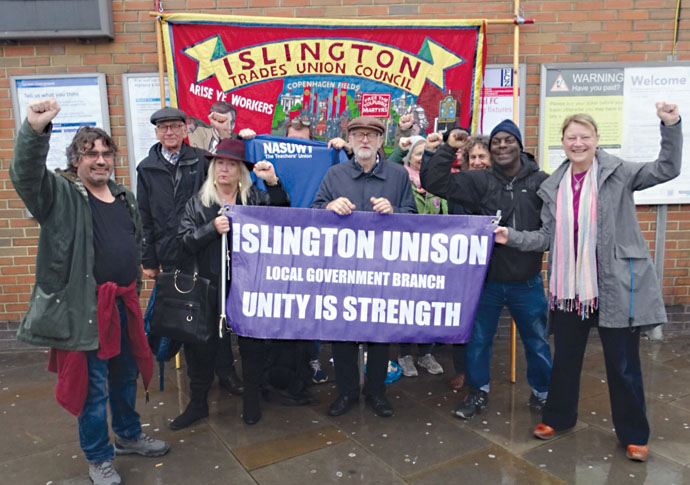A labour of love across two generations
Camden Trades Council vice-chair George Binette delves into a distinctive history of the local building blocks of working-class solidarity
Thursday, 2nd May — By Dan Carrier

Islington North MP Jeremy Corbyn with Islington Trades Council [Picture courtesy of Islington Trades Council]
NEARLY 20 years ago the late and still fondly remembered Nicola Seyd sought to persuade me to become involved with Camden Trades Council. To be frank, I was very sceptical partly because of other commitments, but more because I perceived the local Trades Council as an anachronism that would soon die a natural death.
Still, Nicola persisted with gentle persuasion and so I eventually became a delegate from Camden UNISON. More than 15 years later, despite many moments of doubt in the meantime, Nicola was proved right.
All of which brings me on to a weighty tome, Come Together: Trades Councils 1920-50 (yes, Lennon and McCartney inspired the title), authored by a father and son team, Michael and Jethro Bor, who over the course of nearly 500 pages, replete with 40 pages of references and 848 endnotes, have examined the history of trades councils during what might be deemed their heyday, the three decades from 1920 to 1950. For the authors, the story of trades councils in this period “is . . . a prism in which to analyse the history of Britain”.
In their foreword the authors describe trades councils across these decades as providing “local support to help all workers survive turbulent crises, particularly in the 1930s, which culminated in the “healing process” associated with the post-Second World War Attlee government. A combination of factors, including the comparative success of that Labour government and the dawning of the Cold War, contributed to the declining influence of these bodies over the course of the so-called long boom.
The Bors’ aim, both ambitious and noble, is to excavate and highlight the largely hidden history of these organisations, which undoubtedly played occasionally significant roles in the context of the General Strike of May 1926, a prolonged period of mass unemployment following its defeat and the rise of fascism across Europe. These umbrella bodies of local union representatives were, of course, far from homogenous. In the authors’ words: “Delegates . . . mirrored the fragmentation in their experiences . . . [and were] divided by parochialism.”
As the authors argue persuasively, trades councils were also theatres of ideological conflict between entrenched union bureaucracies at national and regional level, and forces to their left, embodied primarily by the Communist Party of Great Britain (CPGB).
While hardly uncritical of an organisation that was ultimately subservient to the Stalinist regime, which had consolidated power over the Soviet Union and the Communist International, the authors display a good deal of sympathy with CPGB union activists. They muster a good deal of evidence to illustrate “the intensity and magnitude of the witch-hunt” faced by the CPGB’s supporters in the unions.
Drawing on regular documentation across three decades from 20 trades councils scattered across England, Scotland and Wales, the Bors’ work features far more detail from local debates than any previous study with which I am familiar. The book certainly offers a great deal in the way of anecdotal evidence to buttress claims about the TUC’s policing of trades councils’ activities and composition with the often-explicit objective of either curbing or completely eliminating CPGB influence.
At times, however, the level of detail becomes quite overwhelming, disrupting the narrative thread and obscuring rather than illuminating the underlying argument. Even so, the authors have unearthed some nuggets information about the extraordinary effectiveness of some local bodies – for example, Sheffield Trades Council in the early 1940s raised some £5,200 for the Aid to Russia campaign, which would translate into £300,000 in contemporary money.
To borrow from Antonio Gramsci, the authors are “organic intellectuals” with an unapologetic commitment to socialist politics rather than professional historians. As such they sometimes stray from academic conventions, itself no bad thing. At times, though, this reader felt that their work would have benefited from a more linear narrative structure and a clearer exposition of the overarching historical context. Nonetheless, the Bors have made a significant contribution to the study of the 20th-century labour movement in Britain and have laid a foundation stone for future studies of the strengths and weaknesses of trades councils.
The authors’ concluding remarks project an optimistic view of the future potential of trades councils, which might strike many as far removed from the current reality. Certainly, Camden Trades Council rarely matches the challenge posed by its slogan “uniting workers and communities” and yet the local trades council played no small part in generating widespread and ultimately successful opposition to the threatened closure of railway ticket offices last year. The local body has seen a notable increase in affiliated union branches in recent months and a modest uptick in attendance.
The fate of trades councils as a whole is surely linked inextricably to that of the wider trade union and labour movement. In the meantime, these local bodies can play some part in driving a wider resurgence if they have established a presence in key union branches and also developed a tactical flexibility to circumvent obstruction and overcome the inertia that often characterises national and regional union structures.
• Come Together: Trades Councils 1920-50. By Michael Bor and Jethro Bor. Bookguild Publishing, £13.99